|
|
|
|
|
|
| The first part of this page demonstrates how the movie McLintock! (1963) has been reformatted so
that it can be shown on 4:3 pre-digital-standard television screens without black bars at the top and
bottom of the screen. There have been at least two cropped versions prepared of the
movie, which was originally filmed and released in wide-screen. In each group of
three photos, the top image is a frame from the wide-screen edition. Below this are
two images from the same moment in the film as copied from two different reformatted
versions. The image to the lower-left of the wide-screen illustration is always from
the same cropped version as all the other images placed here to the lower-left of the
wide-screen edition. Likewise, the images at the lower-right are all from the same
cropped version as each other. Discerning observers will notice that each cropped
version practices ongoing policies as to selection criteria for inclusion and exclusion of
portions of the original wide-screen image. | |
|
|
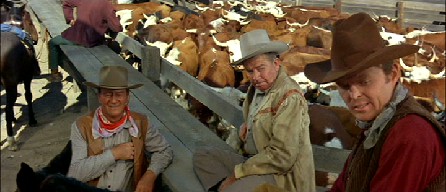 |
|
|
|
|
|
|
 |
|
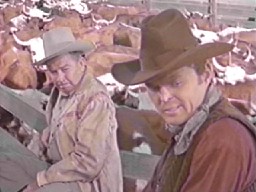 |
|
|
|
|
|
The two cowpokes on the right make statements of interest to
the rancher at left (John Wayne). In the cropped version at right, the viewer isn’t
as clued in that John Wayne is listening, nor that he takes a keen interest. Those
watching the cropped version at left had seen the younger cowpoke earlier in the
conversation. |
|
|
|
|
|
|
|
|
|
 |
|
|
|
|
|
|
 |
|
 |
|
|
|
|
|
The widescreen version shows John Wayne and Chill Wills coming
up to the door of the store (background of image) while the shopkeeper keeps up a
conversation with two women customers already in the store. In the cropped version
at right, when the shopkeeper says “Excuse me” to the two women, the viewer
doesn’t yet know it’s because he sees the two men about to enter. |
|
|
|
|
|
|
|
|
|
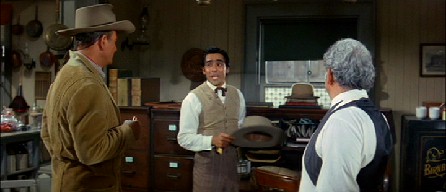 |
|
|
|
|
|
|
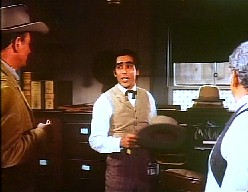 |
|
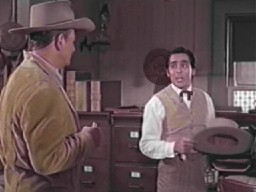 |
|
|
|
|
|
The young shop-clerk talks to John Wayne about hats while the
shopkeeper interjects at times. In the cropped version at right, the viewer has to
react on the basis of his having seen the shopkeeper earlier in the visit. In the
cropped version at left, the new framing awkwardly cuts out part of both John Wayne and
the shopkeeper. |
|
|
|
|
|
|
|
|
|
 |
|
|
|
|
|
|
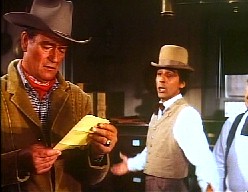 |
|
 |
|
|
|
|
|
The young shop clerk addresses some self-pitying remarks to
John Wayne, but the viewer of the cropped version at right doesn’t see Wayne’s reaction,
nor that he is preoccupied in reading a letter he hadn’t expected to receive. |
|
|
|
|
|
|
|
|
|
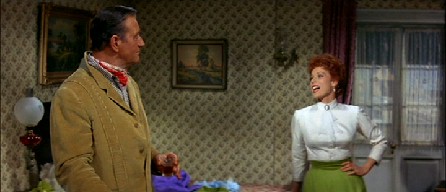 |
|
|
|
|
|
|
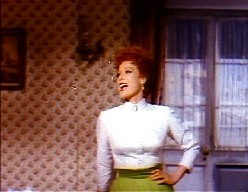 |
|
 |
|
|
|
|
|
The trio of images immediately above and the three images
immediately below are all from the same shot of the movie. John Wayne is having a
bitter conversation with his estranged wife (Maureen O’Hara). In the first trio,
Maureen O’Hara delivers a caustic remark about Wayne as a husband. After further
exchange, John Wayne responds with a plea that she accept his positive feelings about
their daughter. (Wayne’s remark is captured in the second represented by the second
trio.) The cropped version at right maintains framing on Maureen O’Hara, even as she
is only listening. The cropped version at left cuts back and forth from speaker to
speaker. This creates dueling shots of shorter duration, where in the widescreen
version there was no cutting away while this part of the conversation is ongoing. The
editor of the cropped version at left always shows the person speaking, even though at
times this meant showing the side of John Wayne’s face and the back of his head, with no
person’s full face visible. |
|
|
|
|
|
|
|
|
|
 |
|
|
|
|
|
|
 |
|
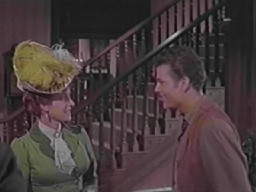 |
|
|
|
|
|
Maureen O’Hara is introduced to her husband’s new hired hand
(played by Patrick Wayne, the real-life son of his acting co-hort). |
|
|
|
|
|
|
|
|
|
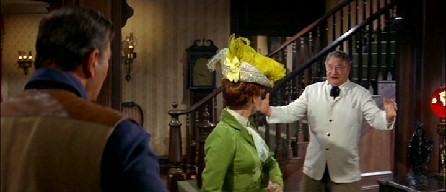 |
|
|
|
|
|
|
 |
|
 |
|
|
|
|
|
Chill Wills welcomes back into the house Maureen O’Hara.
As with the shot immediately above, each of the cropped versions reflects a
different decision as to whether to show just two or all three characters. |
|
|
|
|
|
|
|
|
|
 |
|
|
|
|
|
|
 |
|
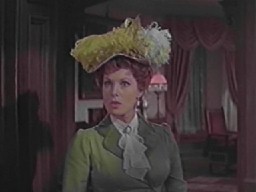 |
|
|
|
|
|
Maureen O’Hara reacts conceitedly to husband John Wayne’s
statement that she is overly concerned with “social prominence.” Only one
of these two cropped versions retains the look on Chill Will’s face that communicates to
the audience the extent of the shock he could tell that the remark made on O’Hara. |
|
|
|
|
|
|
|
|
|
 |
|
|
|
|
|
|
 |
|
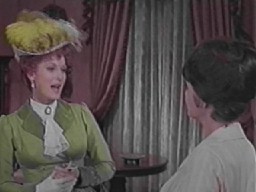 |
|
|
|
|
|
O’Hara meets the newly-hired cook (Yvonne DeCarlo), whom
O’Hara castigates with remarks indicating that she sees the cook as a wily
husband-stealer. The cropped version at right doesn’t preserve John Wayne dismissive
expression about these accusations. |
|
|
|
|
|
|
|
|
|
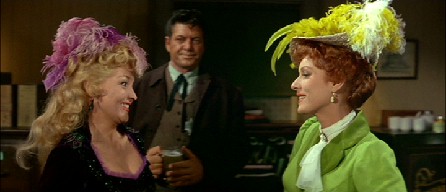 |
|
|
|
|
|
|
 |
|
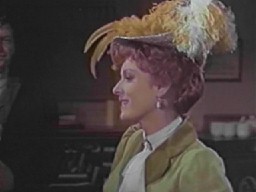 |
|
|
|
|
|
Maureen O’Hara verbally browbeats the saloon girl (Mari
Blanchard) who merely observed the chess game that O’Hara’s husband was playing. |
|
|
|
|
|
|
|
|
|
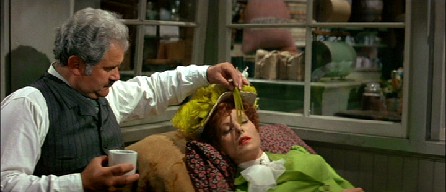 |
|
|
|
|
|
|
 |
|
 |
|
|
|
|
|
After O’Hara faints, the shopkeeper gently awakens her.
As with many shots where the vital characters couldn’t fit into the cropped frame, one
version kept centered the most important character (here it’s O’Hara), whereas the other
version pushed that character to the side so that another character could be substantially
included. |
|
|
|
|
|
|
|
|
|
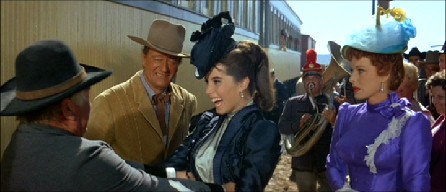 |
|
|
|
|
|
|
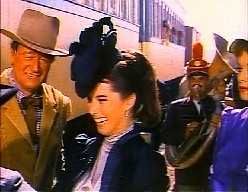 |
|
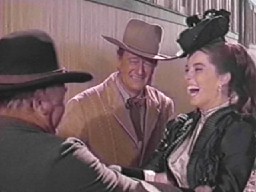 |
|
|
|
|
|
Wayne’s and O’Hara’s daughter (Stephanie Powers) returns from
college. After accepting the cheerful welcomes of her parents and several old-time
friends, she is happy to meet up with Chill Wills. Viewers of the cropped version at
left heard Wills’s voice but did not see him. |
|
|
|
|
|
|
|
|
|
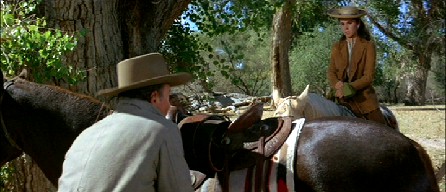 |
|
|
|
|
|
|
 |
|
 |
|
|
|
|
|
Stephanie Powers listens as her father expresses his love for
her through a succession of statements about the choice of a proper husband, the
limitations of inheritance she can expect of him, and his undying love and concern for
her. Although she says nothing, her solemn face reports that his words are accepted
as his tribute to her. Viewers of the cropped version at right might have assumed
she fled, if not physically then perhaps emotionally. These viewers merely heard
Wayne (seemingly) drone while seeing no movement but stirrings of his cheeks which went
into motion in pace with his speaking. |
|
|
|
|
|
|
|
|
|
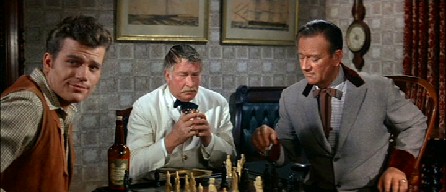 |
|
|
|
|
|
|
 |
|
 |
|
|
|
|
|
Patrick Wayne gets up from the table to look upon the
distracting people elsewhere in the home. In the cropped version at left, the editor
put the focus on the casual actions of John Wayne, which won’t have any further importance
to the development of this scene. |
|
|
|
|
|
|
|
|
|
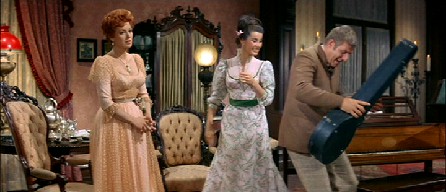 |
|
|
|
|
|
|
 |
|
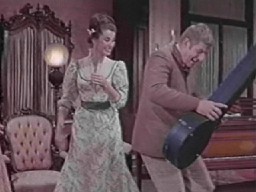 |
|
|
|
|
|
How many people to keep in the shot? Should the person
who is most active be framed nearer the center? Jerry Van Dyke sees an opportunity
to play banjo for the residents in the home he is visiting, even if Maureen O’Hara finds
the hour too late to embark on a new activity. |
|
|
|
|
|
|
|
|
|
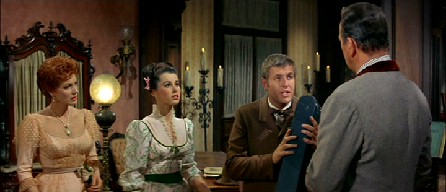 |
|
|
|
|
|
|
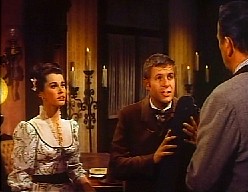 |
|
 |
|
|
|
|
|
Jerry Van Dyke says he didn’t mean offense to John Wayne. |
|
|
|
|
|
|
|
|
|
 |
|
|
|
|
|
|
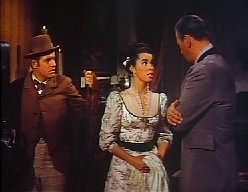 |
|
 |
|
|
|
|
|
Jerry Van Dyke’s horse has bolted (Van Dyke’s left hand holds
the reins which are all he has been left with). Stephanie Powers suggests to her
father that her family’s horse-drawn carriage be used to transport Van Dyke to his
destination, with Stephanie accompanying him. Van Dyke is being discussed, so it was
appropriate that he was left in the cropped version at left. The editor of the
cropped version at right enlarged a small portion of the original image, cutting out more
people than the reduced frame size demanded. Notice that Stephanie has been cut off
above the waist whereas in the original she was framed at her knees. |
|
|
|
|
|
|
|
|
|
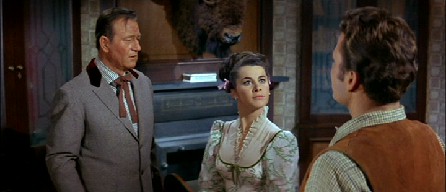 |
|
|
|
|
|
|
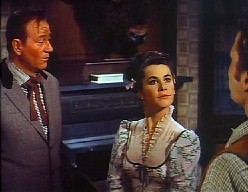 |
|
 |
|
|
|
|
|
Stephanie Powers unconvincingly insists that Patrick Wayne
“impugned my honor.” While wording her statements to her father, she looks
at the man she says is unmannered. Whom she is looking at is not obvious in the
cropped version at right. |
|
|
|
|
|
|
|
|
|
 |
|
|
|
|
|
|
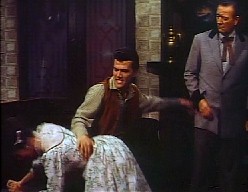 |
|
 |
|
|
|
|
|
What does a young lady deserve once she has been exposed as a
liar whose manipulations could have had drastic consequences on the young man she
maligned? Why, spankings, of course! Patrick Wayne administers justice.
The editor of the cropped version at right did the young lady its own injustice. By
reframing the image to eliminate her head, this version turns the young lady into an
object. The punishment accorded her was not intended to rob her of her
humanity. The cropped version at left respects her in this regard. |
|
|
|
|
|
|
|
|
|
 |
|
|
|
|
|
|
 |
|
 |
|
|
|
|
|
Yvonne DeCarlo is confounded that John Wayne asks that they
both drink a toast to the governor. She doesn’t want to be so discourteous as to
refuse, yet she sees that Wayne is drank so many toasts in the preceding hours that he has
become capricious about the honorees of his imbibing. In the cropped version at
right, the editor enlarged the image of DeCarlo rather than attempting to get in a mere
piece of Wayne or accepting an abundance of background. |
|
|
|
|
|
|
|
|
|
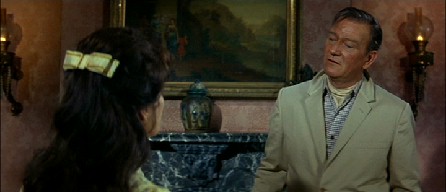 |
|
|
|
|
|
|
 |
|
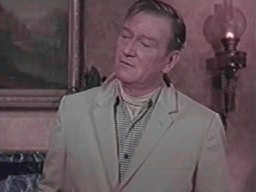 |
|
|
|
|
|
After hesitantly drinking with Wayne, Yvonne tries to tell him
unexpected news. One cropped version shows the person talking (although the audience
sees just the back of her head), while the other chose to show the person listening
(although he hardly moves). |
|
|
|
|
|
|
|
|
|
 |
|
|
|
|
|
|
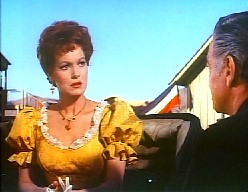 |
|
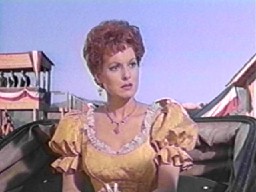 |
|
|
|
|
|
Maureen O’Hara is momentarily silent before summoning within
herself the strength and words to ask the governor (Robert Lowery) a question in response
to his unsettling remark. (His words to her were in the previous shot, where the
audience saw his face as he spoke.) |
|
|
|
|
|
|
|
|
|
 |
|
|
|
|
|
|
 |
|
 |
|
|
|
|
|
Patrick Wayne tells John Wayne that he will be marrying the
elder man’s daughter—“with your permission.” Only one of the cropped
versions shows the to-be bride’s ecstatic gleam. |
|
|
|
|
|
|
|
|
|
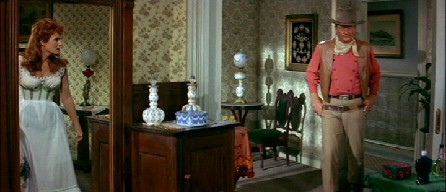 |
|
|
|
|
|
|
 |
|
 |
|
|
|
|
|
John Wayne barges into the hotel room where his wife has taken
refuge. The cropped version at left attempts to represent both people in the room by
showing part of the mirror, but the result is that at one point there is no person in the
frame. (The door is closed as the shot begins, and remains so until John Wayne kicks
away this barrier.) |
|
|
|
|
|
|
|
|
|
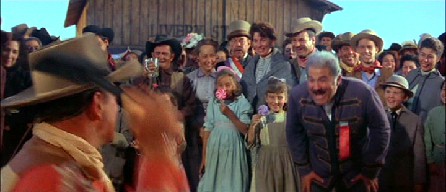 |
|
|
|
|
|
|
 |
|
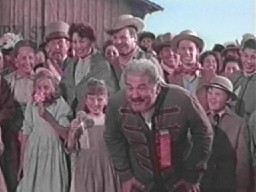 |
|
|
|
|
|
The shopkeeper is thrilled that John Wayne is paddling the
errant wife. (The blur of Wayne’s hand is visible in the widescreen image.)
No, this is not a different point-of-view of the spanking scene reproduced here
earlier—This film has two scenes of a woman’s bottom getting swatted by the man in
her life. The shopkeeper’s exclaiming “My father would be proud” is a
brief interjection in the fabric of an incident where the principal event is the spanking.
In both cropped versions, this focus is lost momentarily, although the sounds and
context continue to indicate that this retaliation is ongoing. |
|
|
|
|
|
Elsewhere in one of the cropped versions, there are a small number of shots in which
the re-editor scanned the image as the shot progressed. In these instances,
the viewer sees an artificial pan shot of the setting. (Artificial is the best term
in that all objects in the scene appear two-dimensional, not showing any new side detail as
the objects move from left to right (or vice-versa) in the shot.) It is from such
new cinematographic manifestations that the term “pan and scan” is applied to
reformatted versions of widescreen movies.
However, in most cases (as with the shots selected above), re-editors maintain the same
reframing from the beginning of a shot to its end. For this reason, the term
“cropped version” is more accurate than “pan and scan.”
To illustrate “pan and scan” on this web page, two shots from McLintock! are reproduced below, each shot in both the widescreen version and a “pan and scan” version. The default settings for these flash videos are for them not to play, so click on the four stills below to activate the video. (There is no sound on these clips.) Note: to control the videos so that the two versions of one shot play in synchronization, you can click on an image to pause and click again to resume. |
|
|
|





